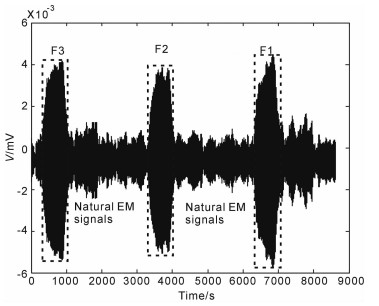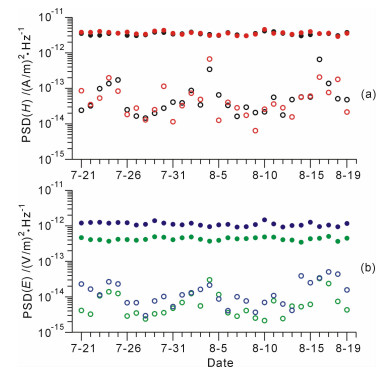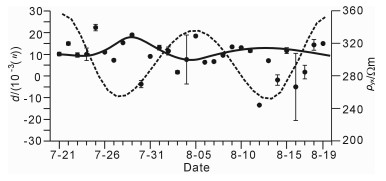2. 北京大学地球与空间科学学院地球物理学系, 北京 100871;
3. 山东省地震局, 济南 250014;
4. 黑龙江省地震局, 哈尔滨 150090
2. Department of Geophysics, School of Earth and Space Sciences, Peking University, Beijing 100871, China;
3. Seismological Bureau of Shandong Province, Jinan 250014, China;
4. Seismological Bureau of Heilongjiang Province, Harbin 150090, China
过去几十年,通过地面和空间观测,记录到地震前大量的电磁异常现象,证明地震电磁效应是确实存在的[1~23].岩石实验和理论模型研究为地震电磁现象的存在也提供了一定的试验和解释依据[24~36].但是,随着经济社会的发展,天然源电磁场的观测面临着日益严重的干扰,如何从复杂的电磁环境中提取与地震活动相关的相对较微弱的电磁信号,是当前地震电磁学研究面临的最重要而且迫切需要解决的问题之一.有时采用新的数据处理技术[37],可以提高数据的信噪比,凸现电磁异常信号.但是,在更多的情况下,需要寻找和发展全新的观测技术,才能根本克服现今大多数地震台站所受到的干扰的影响.
20世纪90年代提出的地震预测人工源大功率超低频/极低频电磁新技术,是在远距离深水通信技术基础上发展起来的.它能够在数千甚至上万公里范围内测量同一个发射源的人工源信号,在没有地震等电磁异常的情况下,能够获得长期的、稳定的、高信噪比的观测数据,具有很强的抗干扰能力.而一旦出现地震等电磁异常时,异常现象能够在稳定的电磁场背景基础上清楚地显现出来,特别有利于对地震电磁异常现象的识别和捕捉.如果在地震活动地区和相对稳定地区布设具有一定密度的监测台网(或台阵)同时进行观测,还能够划定地震电磁异常出现的空间范围,进而追踪地震发生的可能地点.而当把地面观测与空间卫星观测相结合时,可实现真正意义的地震四维监测,因此CSELF技术具有很高的应用价值和发展潜力[15~18, 38~47].本文介绍的是利用这一新技术的最新的试验.
根据国际电联(International Telecommunication Union, ITU)的定义,超低频(Super Low Frequency,SLF)和极低频(Extremely Low Frequency, ELF)的频率范围分别为300~30Hz和30~3Hz,本文研究观测的是该频率范围的人工源电磁场,故简称为人工源极低频电磁技术(Control Source Extremely Low Frequency,CSELF). CSELF技术的电磁信号发射天线位于高电阻率地区,天线两端在低电阻率区接地,天线长度一般为数十公里以上,发射天线电流一般为数十到上百安培[46, 47].
1999年和2005年,我们曾经通过国际合作和与国内有关单位的协作,分别进行了CSELF技术的观测试验,尽管接收台站很少,记录持续时间短,但在试验期间都分别遇到距接收台站100 km左右地区发生的地震,并记录到地震前的电磁异常现象[15~17].2009年,在国家公益性行业专项和基本科研业务专项的支持下,我们进行了这次新的观测试验.
2 观测与数据2009年7月21日到8月19日,利用12个超低频/极低频电磁台站和少量流动观测点,接收测量位于我国大陆某地的大功率发射源的CSELF信号.尽管接收台站和测点少,但分布范围涉及到华北、东北、西北、西南、华南等多个地区.台站测量设备分别为俄罗斯ACF-4M仪器、德国ADU07仪器和加拿大MTU-5A仪器.在每个台站和流动测点,测量南北(x)和东西(y)方向相互垂直的2道水平电场分量和2道相互垂直的水平磁场分量.根据各台站实际条件,测量电场的电极距一般在50~100 m,仪器的采样率都大于设定的最高观测频率的4倍以上.
复原所观测的各电、磁场分量的时间序列,是检验观测数据质量的重要一步.我们利用自主研发的自适应滤波技术[48],通过对仪器记录的原始数据的处理,可得到相应的时间序列.图 1为经过自适应滤波技术得到的时间序列.由图 1可见,在总长度大于8000 s的连续记录中,分别发射的F3,F2和F1三个频率的人工源信号的幅度比天然源信号(无人工源的背景场信号)大3倍以上.

|
图 1 在测点ZB观测的南北电场分量(Ex)经自适应滤波后的时间序列 观测点距离发射源约1000 km,图中三个虚线框标示发射信号频率F3、F2和F1对应的人工源信号时间段,时间段之外为天然源信号.V为电位差. Fig. 1 Time series of electric field in south-north (Ex) at station ZB which is 1000 km away from transmitter after adaptive-filtering. The dotted line blocks indicate the CSELF signalsduringthe transmitter working in frequencies F3、F2 and F1 respectively. The natural signals are outside of the blocks |
经过对台站和观测点每个测量分量时间序列的谱分析,可得到相应时间段、相应频率的功率谱密度(Power Spectrum Density,PSD). 图 2为距发射源约1700 km的台站JH记录的频率为F3的人工源信号及其附近正负2 Hz频率范围的天然源信号的功率谱密度(PSD),可见人工源信号的PSD比天然源信号的PSD大20dB以上.

|
图 2 在JH台站F3±2 Hz频率范围内的磁场(南北分量Hx,东西分量(Hy)和电场(东西分量Ey,南北分量Ex)四个分量的功率谱密度(PSD) Fig. 2 Power spectra density (PSD) for frequency band of F3±2 Hz at station JH. The magnetic PSD are Hx(NS) and Hy (EW) respectively, Ey and Ex are for electric PSD |
在7月21日~8月19日期间,每天在固定时间用基本稳定的发射电流(约110A)发射固定频率的信号,通过对每个台站每天记录的时间序列的分析计算,可得到相应的功率谱密度(PSD)和视电阻率等数据.图 3给出台站HH30天期间的F3频率的人工源信号(CSELF)功率谱密度,每次发射信号持续时间为20 min.为了对比,图 3也给出每天与发射信号时间段相邻时段记录的天然源信号的功率谱密度.由图 3可见,人工源信号的功率谱密度总体上比天然源的约大两个量级.在30天内人工源信号(不论是电场还是磁场分量)的功率谱密度随时间的变化显示,除了7月30日和8月10日两次较大的“异常”外,每天的功率谱密度相对于月平均功率谱密度的差异小于15%.而30天期间,天然源信号的功率谱密度变化较大,达50%以上,甚至达一个数量级.这说明,天然源信号易受外界信号或其他干扰信号的影响,稳定性较差,具有较强随机性.而人工源信号相对变化要小得多,对干扰信号有较强的抑制能力.

|
图 3 在7月21日~8月19日期间,在HH台站F3频率人工源电磁场(实心圆)和天然源电磁场(空心圆)的功率谱密度(PSD)对比 (a)磁场(红色-南北磁场Hx,黑色-东西磁场Hy),(b)电场(蓝色-东西电场Ey,绿色-南北电场Ex). Fig. 3 Comparison of CSELF electro-magnetic PSD (solid dot) and natural electro-magnetic PSD (empty dot) for frequency F3 from July 21 to August 19 (a) Magnetic field (Hx-red color, Hy-black color), (b) Electric field (Ey-blue color, Ex-green color). |
图 4给出人工源电磁场(CSELF)和与其相邻时间段记录的天然源电磁场的相同频率的相干度,其中xy表示南北向电场对应东西向磁场,yx表示东西向电场对应南北向磁场.由图 4可见,人工源信号的相干度都分别接近于最大值1,并在30天期间很稳定.而由于受台站及其附近干扰的影响,天然源信号的相干度在多数日期小于0. 7或0. 6, 且在一个月内的变化很大、很分散.这说明,观测的人工源电磁场的数据质量和稳定性比天然源电磁场要好得多.

|
图 4 在7月21日~8月19日期间HH台站F3频率的相干度 (a)南北向电场对应东西向磁场(xy)的相干度; (b)东西向电场对应南北向磁场(yx)的相干度. Fig. 4 Coherency of CSELF and natural impedances (a) Coherency of Ex relative to Hy, (b) Coherency of Hx relative to Ey. Solid triangle is CSELF signal, empty triangle is Natural signal. |
利用测量的电场和磁场的功率谱密度,可计算得到视电阻率和阻抗相位. 图 5为HH台站F3频率的CSELF视电阻率(ρxy和ρyx)和相位(Φxy和Φxy)在30天期间它们的变化都分别小于10%.而在这期间,用观测的天然源电磁场计算得到的视电阻率和相位的相对变化大于20%,最大可达到110%.

|
图 5 在7月21日~8月19日期间HH台站F3频率的CSELF视电阻率ρ(a)和相位Φ(b). xy-南北向视电阻率和相位,yx-东西向视电阻率和相位. Fig. 5 Apparent resistivity (a) and impedance phase (b) for frequency F3 from July 21 to August 19. xy-Apparent resistivity and phase for SN polarization, yx-Apparent resistivity and phase for EW polarization |
基于上述分析,不论是电磁场的功率谱密度、电磁场的相干度,或者是视电阻率和相位的对比都表明,CSELF的结果都明显优于天然源信号的结果.实际的地震监测试验表明,地震之前地下电阻率的异常变化幅度因地震而异,有时较大,可达20%以上,而有时较小,可能仅为10%左右[2, 4, 6, 15~17].显而易见,利用CSELF技术进行地震监测预测,其分辨率和可信度相对于利用天然源电磁场的具有明显优势.
此外,研究表明,在地面观测的视电阻率日变化还可能与固体潮引起的地形变有一定相关性[16’49~51].基于这一想法,我们计算了HH台站在30天期间每天的固体潮地倾斜日变曲线,然后在每天的日变曲线中,选择与CSELF观测时间相同时刻的地倾斜位移,构制出每天该时刻在30天期间的连续变化曲线. 图 6给出HH台站30天东西向地倾斜位移变化曲线和视电阻率数据的对比.图中显示,30天期间倾斜位移变化曲线和视电阻率变化曲线之间有反向对应的变化趋势.有的研究认为,固体潮汐形变反映了地下介质在某方向的挤压或舒张,它可能引起介质中孔隙流体或水的挤出或吸附,导致介质电阻率相应地发生变化[16, 49],关于它们之间对应关系的原因需要进一步研究.需要指出,在每个台站30天期间,所用的观测设备、观测装置和环境没有发现可观测到的变化,但仍然发现有小于10%的视电阻率的变化,因此推测固体潮汐形变引起的电阻率的变化可能是30天期间电阻率发生变化的原因之一.

|
图 6 在7月21日~8月19日期间HH台站F3频率的视电阻率ρyx(图中圆点)和相同时间固体潮东西向地倾斜位移d(虚线)变化的对比.实线为视电阻率变化的光滑曲线.竖线代表误差棒 Fig. 6 Comparison of CSELF apparent resistivity and tidal displacement in EW direction (d) from July 21 to August 19. Solid dot is ρyx, solid line is smoothed curve of ρyx, dashed line is tidal displacement in EW direction |
此外,通过对比不同台站的观测数据发现:①随着收发距(接收台站和发射源的距离)的增大,接收信号幅度逐渐减小.在相对较近的距离范围内(约1000 km),接收信号的幅度随距离增大而减小得较快,在这个距离之外,随距离增大,信号减小得较慢; ②接收信号的幅度与台站相对于发射天线的方位有关,一般在天线延长线方向,信号最强,在天线赤道方向信号最弱; ③接收信号幅度与台站接收分量的方位有关,当接收分量方位沿源场信号强度分布等值线的切向时,信号幅度最大; ④在一天内不同时间段,观测的信号幅度也有一定变化; ⑤磁场记录比电场更易获得稳定的测量结果,说明电场受到局部地区干扰影响的可能性较大.
4 结语本次连续监测试验时间仅30天,观测台站也较少,观测数据除显示人工源极低频电磁技术(CSELF)相对于天然源电磁观测在地震预测中具有明显的优势外,还显示了观测电磁场和视电阻率随时间和空间位置变化的一些有意义的现象.
在本次试验期间,我国境内没有发生大地震,4级以上的地震距离接受台站一般也都在300 km以上,没有像1999年和2005年试验那样[15~17]监测到地震和电磁异常之间的清楚的对应关系.
研究这些现象的规律和产生的原因,以及要把该技术应用于地震预测,需要更长时间、更密集台站的观测.关于CSELF电磁场信号产生、在波导中的传播及影响因素等有关理论问题仍需要开展相关的研究[47, 48, 52, 53]
同样,适当拓宽发射信号频带范围、增加发射频率数目,CSELF将兼有大地电磁(MT)平面波场覆盖范围大、人工源声频大地电磁(CSAMT)信号强度大等优势,规避它们各自的缺点,在油气和矿产资源勘探等方面发挥重要作用,也是我们以后努力的方向.
致谢本次试验得到国家公益性地震行业专项和中央级公益性科研院所基本科研业务专项的资助.河北省地震局、云南省地震局、四川省地震局、甘肃省地震局、吉林省地震局、山西省地震局、湖北省地震局、海南省地震局、江苏省地震局、福建省地震局、上海地震局、新疆地震局等有关台站参加了观测数据的采集和处理,地震预测研究所张晶研究员计算了固体潮汐形变,与中国科学院研究生院孙文科教授等进行了有益的讨论,在此一并表示感谢.
| [1] | Johnston M, Uyeda S. Electromagnetic methods for monitoring earthquakes and volcanic eruptions. Birmingham IUGG99 Abstract , 1999, July 19-30: A72-A83. |
| [2] | Reddy I K, Phillips R J, Whitcomb J H, et al. Monitoring of time dependent electrical resistivity by magnetotellurics. J.Geomagnetism and Geoelectricity , 1976, 28(2): 165-178. DOI:10.5636/jgg.28.165 |
| [3] | 钱家栋, 曹爱民. 1976年唐山7.8级地震的电阻率和地下水前兆综合物理机制研究. 地震 , 1998, 18(Suppl.): 1–9. Qian J D, Cao A M. Research on comprehensive mechanism of precursors in apparent resistivity and water table associated with 1976 Tangshan earthquake (M=7.8). Earthquake (in Chinese) , 1998, 18(Suppl.): 1-9. |
| [4] | 张云琳, 刘晓玲, 安海静, 等. MT重复测量在地震中短期预报中的应用:祁连山中段MT剖面. 地球物理学报 , 1994, 37(2): 200–210. Zhang Y L, Liu X L, An H J, et al. Application of the MT repeated measurements to the medium and short term prediction of earthquake:Monitoring and studying a profile in the middle segment of Qilian Mountain by MT. Chinese J.Geophys. (in Chinese) , 1994, 37(2): 200-210. |
| [5] | 聂永安, 崔晓峰, 冯德益, 等. 地震前后祁连山中段深部电性变化的跟踪研究. 地震地磁观测与研究 , 1995, 16(3): 15–20. Nie Y A, Cui X F, Feng D Y, et al. Research on variance of electrical resistivity at middle Mt.Qilian before and after earthquakes. Seismological and Geomagnetic Observation and Research (in Chinese) , 1995, 16(3): 15-20. |
| [6] | 汤吉, 赵国泽, 王继军, 等. 张北-尚义地震前后电阻率的变化及分析. 地震地质 , 1998, 20(2): 164–171. Tang J, Zhao G Z, Wang J J, et al. Variation and analysis of resistivity before and after the Zhangbei-Shangyi earthquake. Seismology and Geology (in Chinese) , 1998, 20(2): 164-171. |
| [7] | Uyeda S, Hayakawa M, Nagao T, et al. Electric and magnetic phenomena observed before the volcano-seismic activity in 2000 in the Izu Island region, Japan. Proceedings of the National Academy of Sciences of the United States of America , 2002, 99(11): 7352-7355. DOI:10.1073/pnas.072208499 |
| [8] | Bhattacharya S, Sarkar S, Gwal A K, et al. Satellite and ground based ULF/ELF emissions observed before Gujarat earthquake in March 2006. Current Science , 2007, 93(1): 41-46. |
| [9] | 黄清华. 地震电磁观测研究简述. 国际地震动态 , 2005, 11: 2–5. Huang Q H. State-of-the art in Seismic Electromagnetic Observation. Recent Developments in World Seismology (in Chinese) , 2005, 11: 2-5. |
| [10] | 丁鉴海, 申旭辉, 潘威炎, 等. 地震电磁前兆研究进展. 电波科学学报 , 2006, 21(5): 791–801. Ding J H, Shen X H, Pan W Y, et al. Seismo-electromagnetism precursor research progress. Chinese Journal of Radio Science (in Chinese) , 2006, 21(5): 791-801. |
| [11] | 赵国泽, 陈小斌, 蔡军涛, 等. 电磁卫星和地震预测. 地球物理学进展 , 2007, 22(3): 667–673. Zhao G Z, Chen X B, Cai J T, et al. Electromagnetic observation by satellite and earthquake prediction. Progress in Geophysics (in Chinese) , 2007, 22(3): 667-673. |
| [12] | 张学民, 赵国泽, 陈小斌, 等. 国外地震电磁现象观测. 地球物理学进展 , 2007, 22(3): 687–694. Zhang X M, Zhao G Z, Chen X B, et al. Seismo-electromagnetic observation abroad. Progress in Geophysics (in Chinese) , 2007, 22(3): 687-694. |
| [13] | 钱复业, 赵玉林, 于谋明, 等. 地震前地电阻率异常变化. 中国科学B辑 , 1982, 12(9): 831–839. Qian F Y, Zhao Y L, Yu M M, et al. Electrical resistivity anomaly before earthquake. Science in China (Serious B) (in Chinese) , 1982, 12(9): 831-839. |
| [14] | 钱复业, 赵璧如, 钱卫, 等. 2009年汶川8.0级地震HRT波地震短临波动前兆及HRT波地震短临预测方法-关于实现强震短临预测可能性的讨论. 中国科学(D辑) , 2009, 52(10): 1572–1584. Qian F Y, Zhao B R, Qian W, et al. Impending HRT wave precursors to the Wenchuan M_s8. 0 earthquake and methods of earthquake impeding prediction by using HRT wave.Science in China (D) (in Chinese) , 2009, 52(10): 1572-1584. |
| [15] | 赵国泽, 陆建勋. 利用人工源超低频电磁波监测地震的试验与分析. 中国工程科学 , 2003, 5(10): 27–32. Zhao G Z, Lu J X. Monitoring & analysis of earthquake phenomena by artificial SLF waves. Engineering Science (in Chinese) , 2003, 5(10): 27-32. |
| [16] | 赵国泽, 汤吉, 邓前辉, 等. 人工源超低频电磁波技术及在首都圈地区的测量研究. 地学前缘 , 2003, 10(Suppl.): 248–257. Zhao G Z, Tang J, Deng Q H, et al. Artificial SLF method and the experimental study for earthquake monitoring in Beijing area. Earth Science Frontiers (in Chinese) , 2003, 10(Suppl.): 248-257. |
| [17] | Zhao G Z, Zhan Y, Wang L F, et al. Electromagnetic anomaly before earthquakes measured by electromagnetic experiments. Earthquake Science , 2009, 22: 395-402. DOI:10.1007/s11589-009-0395-5 |
| [18] | 赵国泽, 陈小斌, 汤吉. 中国地球电磁法新进展和发展趋势. 地球物理学进展 , 2007, 22(4): 1171–1180. Zhao G Z, Chen X B, Tang J. Advanced geo-electromagnetic methods in China. Progress in Geophysics (in Chinese) , 2007, 22(4): 1171-1180. |
| [19] | Huang Q.Geophysical measurements associated with the Ms8.0 Wenchuan earthquake in Sichuan, China.Eos Trans.AGU, 2008, 89(53), Fall Meet.Suppl., Abstract S52A-02(INVITED) |
| [20] | Du A, Huang Q, Yang S. Epicenter location by abnormal ULF electromagnetic emissions. Geophysical Research Letters , 2002, 29(10): 1455. DOI:10.1029/2001GL013616 |
| [21] | 张继红, 乔惠珍. 地磁前兆异常的动态从属函数. 地球物理学进展 , 2005, 20(1): 142–146. Zhang J H, Qiao H Z. Precursory anomalies of geomagnetic field dynamic subordinate function method. Progress in Geophysics (in Chinese) , 2005, 20(1): 142-146. |
| [22] | 张继红, 张京华, 刘敏, 等. 地震前电磁辐射异常变化特征. 地震地磁观测与研究 , 2001, 22(5): 71–74. Zhang J H, Zhang J H, Liu M, et al. The variational features of electromagnetic emission anomaly before earthquake. Seismological and Geomagnetic Observation and Research (in Chinese) , 2001, 22(5): 71-74. |
| [23] | 张继红, 张琨. 华北地区地磁前兆异常特征的研究. 东北地震研究 , 2001, 17(4): 21–27. Zhang J H, Zhang K. Study on the precursory anomalous characteristics of geomagnetic field in north China. Seismological Research of Northeast China (in Chinese) , 2001, 17(4): 21-27. |
| [24] | Morat P, Le J L Mouel. Variation of the electrical resistivity of large rock samples with stress. Geophysics , 1987, 52: 1424-1430. DOI:10.1190/1.1442255 |
| [25] | O'Keefe S G, Thiel D V. Electromagnetic emissions during rock blasting. Geophys.Res.Lett. , 1991, 18: 889-892. DOI:10.1029/91GL01076 |
| [26] | 郭自强. 地震低频电磁辐射研究. 地球物理学报 , 1994, 37(1): 261–268. Guo Z Q. Investigation on low-frequency seismoeletromagnetic mission. Chinese J.Geophys (in Chinese) , 1994, 37(1): 261-268. |
| [27] | 钱书清, 郝锦绮, 周建国, 等. 1999年9月21日台湾集集M_s7. 4地震前ULF电磁信号及其与模拟试验结果的比较.地震学报 , 2001, 23(3): 322–327. Qian S Q, Hao J Q, Zhou J G, et al. ULF electromagnetic precursors before 1999 Jiji, Taiwan earthquake and the comparison with results of simulating experiments. Acta Seismologica Sinica (in Chinese) , 2001, 23(3): 322-327. |
| [28] | Frid V, Bahat D, Goldbaum J, et al. Experimental and theoretical investigation of electromagnetic radiation induced by rock fracture. Israel Journal of Earth Sciences , 2000, 49: 9-19. DOI:10.1560/6LMJ-ABWH-MBEL-FRTY |
| [29] | 王继军, 赵国泽, 詹艳, 等. 中国地震电磁现象的岩石实验研究. 大地测量与地球动力学 , 2005, 25(2): 22–28. Wang J J, Zhao G Z, Zhan Y, et al. Rock experiments for research on seismic electromagnetic phenomena in China. Crustal Deformation and Earthquake (in Chinese) , 2005, 25(2): 22-28. |
| [30] | 王立凤, 王继军, 陈小斌, 等. 岩石破裂电磁辐射(EMR)现象实验研究. 地球物理学进展 , 2007, 22(3): 715–719. Wang L F, Wang J J, Chen X B, et al. Experimental and theoretical investigations of electromagnetic radiation induced by rock fracture. Progress in Geophysics (in Chinese) , 2007, 22(3): 715-719. |
| [31] | 万战生, 赵国泽, 陈小斌, 等. 岩石圈地震前兆异常机制. 地球物理学进展 , 2007, 22(3): 708–714. Wan Z S, Zhao G Z, Chen X B, et al. Mechanism of the lithosphere earthquake precursor anomalous phenomena. Progress in Geophysics (in Chinese) , 2007, 22(3): 708-714. |
| [32] | 黄清华. 地震电磁信号传播的控制模拟实验. 科学通报 , 2005, 50(17): 1956–1961. Huang Q H. Controlled analogue experiments on propagation of seismic electromagnetic signals. Chinese Science Bulletin (in Chinese) , 2005, 50(17): 1956-1961. DOI:10.1360/982004-312 |
| [33] | Huang Q H.Theoretical and experimental study on seismoelectric signals and earthquake-ralated phenomena[Ph.D.thesis].Japan:Osaka Univ., 1999.107 |
| [34] | Huang Q H, Ikeya M. Seismic electromagnetic signals (SEMS) explained by a simulation experiment using electromagnetic waves. Phys.Earth Planet.Inter. , 1998, 109(3-4): 107-114. DOI:10.1016/S0031-9201(98)00135-6 |
| [35] | Huang Q H, Ikeya M. Experimental study on the propagation of seismic electromagnetic signal (SEMS) using a minigeographic model of the Taiwan strait. Episodes , 1999, 22(4): 289-294. |
| [36] | Huang Q H, One possible generation mechanism of co-seismic electric signals. Proc. Japan Acad. , 2002, 78(B7): 173-178. |
| [37] | 韩鹏, 黄清华, 修济刚. 地磁日变与地震活动关系的主成分分析-以日本岩手县北部6.1级地震为例. 地球物理学报 , 2009, 52(6): 1556–1563. Han P, Huang Q H, Xiu J G. Principal component analysis of geomagnetic diurnal variation associated with earthquakes:case study of the M6. 1 Iwate-ken Nairiku Hokubu earthquake.Chinese J.Geophys (in Chinese) , 2009, 52(6): 1556-1563. |
| [38] | Bannister P R. Summary of the Wisconsin Test Facility effective earth conductivity measurements. Radio Science , 1976, 11(4): 405-411. DOI:10.1029/RS011i004p00405 |
| [39] | Dill M. ELF ground design and installation. IEEE Journal of Oceanic Engineering , 1984, 9(3): 128-135. DOI:10.1109/JOE.1984.1145621 |
| [40] | Freser Smith A C, Bannister P R. Reception of ELF signal at antipodal distance. Radio Science , 1998, 33(1): 83-88. DOI:10.1029/97RS01948 |
| [41] | Meloni A, Palangio P, Fraser-Smith A C. Some characteristics of the ELF/VLF radio noise measured near L'Aquila, Italy. IEEE Transactions on Antennas and Propagation , 1992, 40(2): 233-236. DOI:10.1109/8.127409 |
| [42] | Sainita R A, Wolkoff E A. Application of magnetotelluric techniques at extremely low frequency (ELF) for Sanguine transmitting antenna. IEEE Transactions on Communica-tions , 1974, 22(4): 394-398. DOI:10.1109/TCOM.1974.1092202 |
| [43] | Velikhov E P, Zhamaletdinov A A, Sobchakov L A, et al. Extra-low frequency sounding of the Earth's crust with a high-power antenna. Dokl.Acad.Sci.USSR, Earth Sci.Ser., Engl.Transi , 1996, 341: 12-16. |
| [44] | Davidson D, Macklin D N, Vozoff K. Resistivity surveying as an aid in Sanguine site selection. IEEE Transactions on Communications , 1974, 22(4): 389-393. DOI:10.1109/TCOM.1974.1092201 |
| [45] | Barr R, Jones D Llanwyn, Rodger C J. ELF and VLF radio waves. Journal of Atmospheric and Solar-Terrestrial Physics , 2000, 62(17-18): 1689-1718. DOI:10.1016/S1364-6826(00)00121-8 |
| [46] | 陈小斌, 赵国泽. 关于人工源超低频电磁波发射源的讨论--均匀交流点电流源的解. 地球物理学报 , 2009, 52(8): 2158–2164. Chen X B, Zhao G Z. Study on the transmitting mechanism of CSELF waves:response of the alternating current point source in the uniform space. Chinese J.Geophys (in Chinese) , 2009, 52(8): 2158-2164. DOI:10.3969/j.issn.issn.0001.5733.2009.08.026 |
| [47] | 柳超, 翟琦, 谢慧, 等. 极低频发射天线场地等效视电阻率的计算. 西安电子科技大学学报 , 2005, 32(4): 584–586. Liu C, Zhai Q, Xie H, et al. A calculating method of the effective apparent resistivity for the extremely low frequency transmitting antenna site. Journal of Xidian University (in Chinese) , 2005, 32(4): 584-586. |
| [48] | 汪晓.人工源SLF/ELF电磁信号提取及初步数据处理[硕士论文].北京:中国地震局地质研究所, 2008. Wang X.Extractive processing of SLF/ELF electromagnetic signals[Master thesis](in Chinese).Beijing:Institute of Geology, China Earthquake Administration, 2008 |
| [49] | Saraev A, Pertel M, Molkin Z. Correction of the electromagnetic monitoring data for tidal variations of apparent resistivity. J.Applied Geophysics , 2002, 49: 91-100. DOI:10.1016/S0926-9851(01)00101-X |
| [50] | 黄清华, 刘涛. 新岛台地电场的潮汐响应与地震. 地球物理学报 , 2006, 49(6): 1745–1754. Huang Q H, Liu T. Earthquakes and tide response of geoelectric potential field at the Niijima station. Chinese J.Geophys (in Chinese) , 2006, 49(6): 1745-1754. |
| [51] | 张晶, 江在森, 方颖, 等. 文安地震与首都圈地区数字化应变资料分析. 地震 , 2007, 27(1): 39–46. Zhang J, Jiang Z S, Fang Y, et al. Analysis on digital strain observation before Wen'an earthquake in Capital Circle Area. Eatherquake (in Chinese) , 2007, 27(1): 39-46. |
| [52] | 熊皓. 电磁波传播与空间环境. 北京: 电子工业出版社, 2004 . Xiong H. Electromagnetic Wave Propagation and Space Environment (in Chinese). Beijing: Publishing House of Electronics Industry, 2004 . |
| [53] | 梁高权. 加热电离层辐射甚低频和超低频波. 海军工程大学电子工程学院学报 , 2000(2): 54–57. Liang G Q. IH induced VLF/SLF EM wave. Hai Jun Gong Cheng Da Xue Dian Zi Gong Cheng Xue Yuan Xue Bao (in Chinese) , 2000(2): 54-57. |
 2010, Vol. 53
2010, Vol. 53


